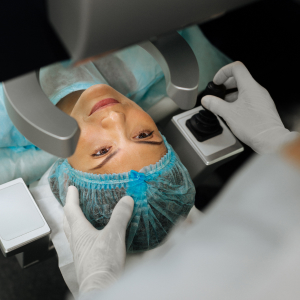- 541-884-3148
- info@klamatheyecenter.com
- 08:00AM to 5:00PM
Corneal Surgery
Corneal Transplant Surgery (Keratoplasty)

Corneal transplant surgery — also called keratoplasty — preserves or restores vision impaired by advanced corneal disease or when the cornea has been damaged by scarring, trauma, or infection. Duke corneal surgeons have extensive experience and perform hundreds of corneal transplants each year using the latest advances. Our goal is to recover or preserve your vision and help you return to your daily activities as soon as possible.
When Is Corneal Transplant Surgery Necessary?
You may be a candidate for corneal transplantation if you have been diagnosed with keratoconus, which causes your cornea to become thin and cone-shaped, or when an inherited corneal dystrophy, such as Fuchs’ dystrophy, results in vision-impairing corneal swelling and clouding. You may also be a candidate for corneal transplantation if your cornea has been damaged by infection, scarring, or trauma.

The procedure is typically recommended when less-invasive corneal disease treatments such as special glasses or contact lenses and medications to reduce swelling cannot halt the progression of your corneal disease.
There are several types of corneal transplant procedures to remove damaged, unhealthy cornea tissue. After a comprehensive evaluation that includes sophisticated imaging of your cornea, we can recommend the most effective procedure for your condition.
Surgical Techniques
These procedures are alternatives to full-thickness corneal transplants. In these surgeries, the surgeon replaces only certain layers of your cornea with donor tissue. The type of procedure you receive depends on which parts of your cornea are diseased. Procedures include Descemet’s stripping endothelial keratoplasty (DSEK), Descemet’s membrane endothelial keratoplasty (DMEK), and deep anterior lamellar keratoplasty (DALK).
A full thickness corneal transplant — also called penetrating keratoplasty (PK) — removes all layers of the diseased cornea and replaces them with clear, healthy cornea tissue from a donor. You should see some improvement after one to two weeks, but it may take up to one year for your vision to reach its maximum potential.
This procedure restores vision by removing the severely damaged or diseased cornea and replacing it with an acrylic, artificial cornea and donor corneal tissue that is sutured in place. This is typically only recommended when natural transplants have failed.
Tests for Corneal Disorders
Your corneal surgeon will conduct a thorough examination of your eye and its structures using a variety of imaging devices to help diagnose any corneal disorders or diseases.
A computer-guided device creates a 3D image map of your cornea to measure corneal power, curvature, and thickness.
Ultrasound waves measure the thickness of your cornea.

This exam gives your doctor a magnified, 3D view of the structures at the front of your eye.
By measuring the curvature of your cornea’s front surface, your doctor can assess astigmatism.
Your doctor examines the cellular structure of your cornea. This exams allows them to see normal and abnormal cells in the various corneal layers (epithelium, Bowman’s layer, stroma, Descemet’s membrane, and endothelium) as well as infectious cells such as fungi and amoeba.

Choosing a Corneal Transplant Surgeon
Our corneal surgeons are ophthalmologists who have undergone advanced training in the medical and surgical management of corneal disease.
We use the latest techniques to remove only the diseased portion of the cornea, rather than all the layers of the cornea, when appropriate. These new corneal transplant procedures retain the structural integrity of your eye, minimize your risk of rejection, quicken your recovery, and improve your vision.
We have access to advanced, high-resolution imaging, which can be used during procedures to more precisely perform and monitor corneal transplant surgery.
We are one of the few eye centers in the region with the surgical skill and expertise to treat advanced corneal disease with artificial cornea implants (keratoprosthesis). This may be an option if you have not had success with standard corneal transplants.
Our researchers are studying new ways to use OCT, a noninvasive imaging technology that allows us to look closely at the cornea and assess the severity of your corneal disease. This helps us make the best treatment recommendations for your condition.
We offer patient support services, including educational materials and programs, a low vision rehabilitation program, and a dedicated social worker to help you and your loved ones manage your condition and maximize your quality of life.
